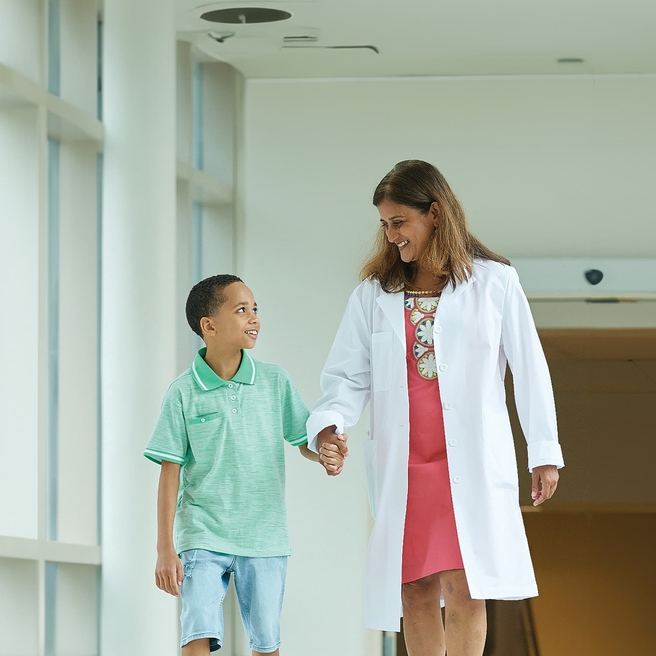What is transposition of the great arteries (TGA)?
Transposition of the great arteries (TGA) is a complex congenital heart defect. In a normal heart, there are two large arteries that carry blood out of the heart. The pulmonary artery is the blood vessel that that pumps blood from the heart to the lungs. The aorta is the blood vessel that pumps oxygen-rich blood to the body. In children with TGA, these arteries are connected to the heart abnormally:
- The aorta is attached to the right-sided pumping chamber (right ventricle), instead of the left.
- The pulmonary artery is attached to the left-sided pumping chamber (left ventricle), instead of the right.
Learn more about TGA from the experts at Children's Hospital of Philadelphia's Cardiac Center and Fetal Heart Program in this video series:
Signs and symptoms of transposition of the great arteries
The symptoms of TGA include:
- Blue or purple tint to lips, skin and nails (cyanosis)
- Rapid breathing
- Difficulty feeding, poor appetite and poor weight gain
Testing and diagnosis of TGA
TGA may be diagnosed before birth using a special ultrasound called a fetal echocardiogram. Our Fetal Heart Program leads the nation in the evaluation, diagnosis and treatment of fetal heart disease before birth. Our experts will monitor both you and your baby throughout your pregnancy and create a plan for labor and care for your newborn after birth.
Sometimes TGA is diagnosed a few hours or days after a baby is born. Rarely, a baby may not have visible symptoms for weeks or months. Pediatricians from other hospitals refer newborns to the Cardiac Center when they notice symptoms or unusual results on tests like pulse oximetry, which is a non-invasive way to measure the amount of oxygen in the blood.
Diagnosing TGA may require some or all of these tests:
- Electrocardiogram (EKG or ECG), which is a record of the electrical activity of the heart
- Echocardiogram (also called echo or ultrasound), which is when sound waves create an image of the heart
- Chest X-ray
- Cardiac MRI, or CT scan, which is a 3D image that shows the heart's structures in detail
Sometimes, cardiac catheterization will be required. A thin, flexible tube (catheter) is inserted through a vein or artery in the leg and into the heart to provide detailed information about the structure and function of the heart and lungs.
Treatment for transposition of the great arteries
About one-third of babies born with TGA have extremely low oxygen levels that can harm their bodies and will require an urgent intervention, called a balloon atrial septostomy (BAS), within hours of birth.
The balloon atrial septostomy was developed here at CHOP by Dr. William Rashkind. This life-saving procedure creates or enlarges a hole between the upper chambers of the heart to allow red (oxygenated) and blue (de-oxygenated) blood to mix.
For babies requiring a BAS procedure, access to immediate expert care is essential to survival. We may recommend that these babies be delivered in the Richard D. Wood Jr. Center for Fetal Diagnosis and Treatment’s Garbose Family Special Delivery Unit (SDU), the world’s first birthing facility for healthy mothers carrying babies with known birth defects. The SDU is just steps away from our cardiac operative and catheterization facilities.
All children with transposition of the great arteries will require open heart surgery to treat the defect. Without surgical repair, most babies with TGA will not survive their first year of life. The surgery, known as the arterial switch operation, is typically performed within a few days of birth.
During an arterial switch operation, a surgeon will reconstruct the heart so that the aorta is attached to the left ventricle and the pulmonary artery is attached to the right ventricle. This restores normal circulation.
After surgery your child will recover in our Evelyn and Daniel M. Tabas Cardiac Intensive Care Unit (CICU), where they will receive round-the-clock attention from a team of dedicated cardiac critical care medicine specialists.
Outlook for TGA
Most children born with TGA will go on to lead healthy, productive lives, and are usually able to participate in normal day-to-day activities, including sports, without limitations. However, it’s important to talk to your child’s cardiologist about how much physical activity is safe for your child.
Follow-up care for TGA
Through age 18
Children who have had surgical repair of TGA require lifelong care by a cardiologist. Your child’s cardiologist may:
- Perform heart tests, including ECGs, echocardiograms, cardiac MRIs and exercise stress tests.
- Monitor your child’s cholesterol level, especially if there is a family history of adult acquired heart disease.
- Monitor for any narrowing where the blood vessels were connected during surgery. Mild narrowing is okay, but more severe narrowing may require treatment.
- Evaluate heart muscle and valve function over time. The old pulmonary valve and tissue around it, which now works as the new aortic valve on the left side of the heart, can stretch over time, which can cause the valve to leak.
Just like with all complex congenital heart conditions, your child might need additional surgeries as they grow. However, they probably will not need to take medicine long term.
Into adulthood
Our pediatric cardiologists follow patients until they are young adults. The Philadelphia Adult Congenital Heart Center, a joint program of CHOP and Penn Medicine, meets the unique needs of adults who were born with heart defects. At CHOP’s Cardiac Center, we support our adolescent and young adult patients through a smooth and seamless transition to adult cardiology care at the Philadelphia Adult Congenital Heart Center or, if desired, to a cardiologist with congenital heart disease expertise in another location.

Patient Outcomes at the Cardiac Center
Children’s Hospital of Philadelphia's pediatric heart surgery survival rates are among the best in the nation.
Resources to help
Cardiac Center Resources
We know that caring for a child with a heart condition can be stressful. To help you find answers to your questions – either before or after visiting the Cardiac Center – we’ve created this list of educational health resources.
Reviewed by Jenna Heichel, MSN, BSN, CRNP
Reviewed on 08/08/2024

